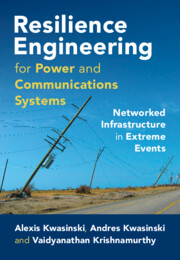 Resilience Engineering for Power and Communications Systems
Resilience Engineering for Power and Communications Systems Book contents
- Resilience Engineering for Power and Communications Systems
- Resilience Engineering for Power and Communications Systems
- Copyright page
- Contents
- Preface
- Acknowledgments
- 1 Introduction
- 2 Fundamental Supporting Concepts
- 3 Resilience Models and Metrics
- 4 Dependencies and Interdependencies and Their Effect on Resilience
- 5 Disaster Forensics of Infrastructure Systems
- 6 Electric Power Grid Resilience
- 7 Resilience of Information and Communication Networks
- 8 Integrated Electric Power and Communications Infrastructure Resilience
- 9 Infrastructure Systems Planning for Improved Resilience
- Index
- References
7 - Resilience of Information and Communication Networks
Published online by Cambridge University Press: 04 January 2024
- Resilience Engineering for Power and Communications Systems
- Resilience Engineering for Power and Communications Systems
- Copyright page
- Contents
- Preface
- Acknowledgments
- 1 Introduction
- 2 Fundamental Supporting Concepts
- 3 Resilience Models and Metrics
- 4 Dependencies and Interdependencies and Their Effect on Resilience
- 5 Disaster Forensics of Infrastructure Systems
- 6 Electric Power Grid Resilience
- 7 Resilience of Information and Communication Networks
- 8 Integrated Electric Power and Communications Infrastructure Resilience
- 9 Infrastructure Systems Planning for Improved Resilience
- Index
- References
Summary
This chapter is dedicated to examining technologies and strategies for improved resilience of information and communications networks. Initially, this chapter describes typical service requirements for information and communications networks by discussing services provision expectations. These expectations are presented in context by describing typical regulatory environments observed in the United States and other countries, placing special attention on emergency 911 regulations. The second part of this chapter provides an overview of most commonly observed strategies and technologies used to improve resilience. These strategies and technologies include resources management approaches, as well as hardware- and software-based technologies.
Keywords
- Type
- Chapter
- Information
- Resilience Engineering for Power and Communications SystemsNetworked Infrastructure in Extreme Events, pp. 381 - 422Publisher: Cambridge University PressPrint publication year: 2024
